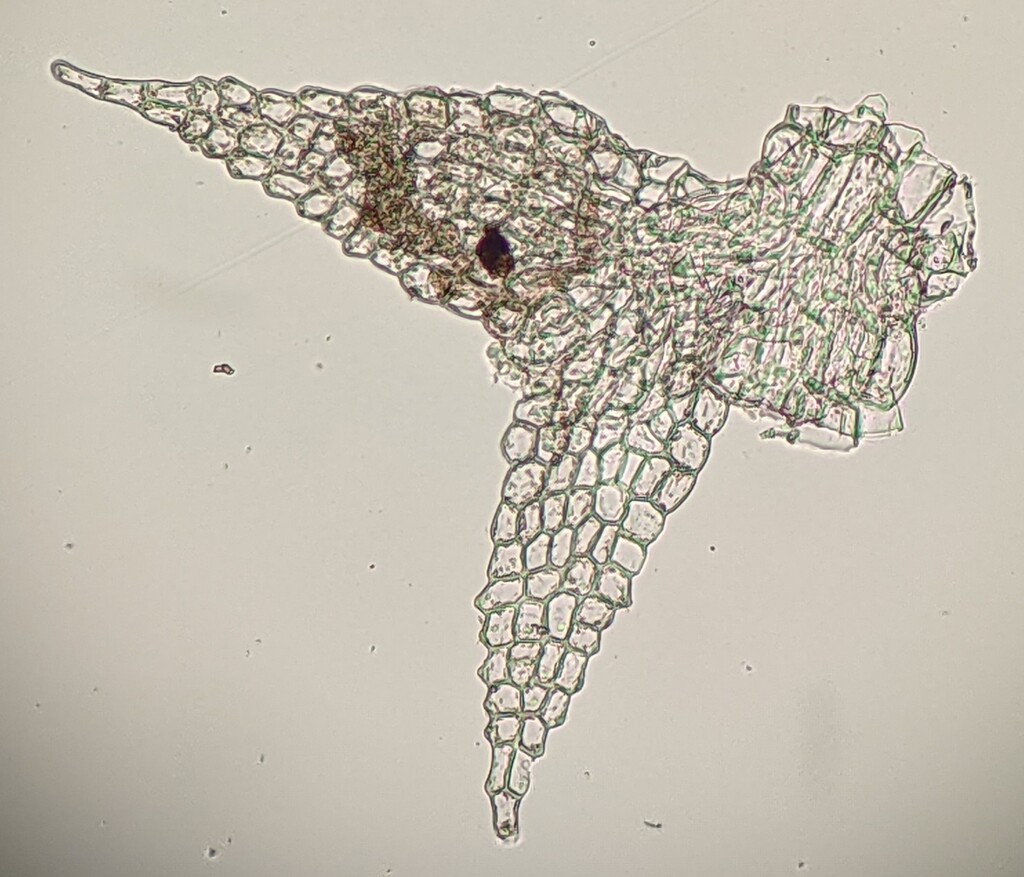Colura
Epiphyllous usually on ferns, rarely (not in Victoria) on branches, trunks or rocks, monoicous or dioicous. Asexual reproduction by discoid gemmae formed near the apex of the lobule or lobe, rarely from perianth (not in Victoria). Stems sparingly to frequently (not in Victoria) irregularly branching; branches emerging from main stem ventral to an unmodified lateral leaf and with a lobed and foliose collar at base. Leaves distant to imbricate, rising away from substrate, narrowly attached to stem; lobe ovate, rectangular, elliptic (not in Victoria), falcate (not in Victoria) or semicircular (not in Victoria), entire, crenulate or dentate (not in Victoria); lobule smaller (not in Victoria) or larger than lobe, with a tubular or flat (not in Victoria) base, following the basal margin of the leaf, often abruptly expanding toward the apex into a saccate apical section, overall appearing spathulate or clavate, or confined to basal margin to near leaf apex, without abruptly expanding, and cylindric or narrowly clavate to oblanceolate (not in Victoria), fused along its apical margin with lobe up to an opening to lobule facing toward stem and sealed by a lid formed of lobule tissue, rarely lobule not forming in some leaves (not in Victoria), rounded or with an elongate horn at the apex (not in Victoria); lid attached to a series of specialised hinge cells and moveable or fused directly to lobe and fixed (not in Victoria); cells quadrate or rectangular to polygonal, smooth or sometimes with a single papilla in saccate apical part of lobule, evenly firm-walled or with distinct trigones and intermediate thickenings (not in Victoria), with several ellipsoid botryoidal oil bodies. Underleaves present, one to each lateral leaf, V-shaped or rarely obcuneate and emarginate (not in Victoria) or with four lobes (not in Victoria), distant to imbricate (not in Victoria); lobes entire or dentate with projecting cells (not in Victoria); cells quadrate or rectangular to polygonal, smooth, evenly firm-walled or with distinct trigones and intermediate thickenings (not in Victoria), with several ellipsoid botryoidal oil bodies. Perianth conic to pyriform or cylindric (not in Victoria), 3- (not in Victoria) or 5-plicate, sometimes with 5 short apical horns, sometimes covered in tubercles, with a short beak at apex.
Eighty-one species mostly in tropical and subtropical regions throughout the world but extending into southern temperate regions and Europe (Söderström et al. 2016); one species, C. pulcherrima Jovet-Ast, in Victoria.
The inflated lobule in this genus forms a water sac that is sealed by a lid that in many species, including the Victorian species, can open and close. In species with a moveable lid, the lid is attached by a series of cells that act as a hinge (Jovet-Ast 1953). When dry the lid is open and when the hinge cells are turgid the lid closes (Hess et al. 2005). This sealing mechanism has been shown to capture ciliates that consume bacteria on the leaf surface and the occasional presence of invertebrates within the lobules suggest that they can also capture these organisms (Barthlott et al 2000; Hess et al. 2005). The excretion and decomposition of these organisms, once trapped, could possibly provide supplementary nitrogen for the plant.
Barthlott, W., Fischer, E., Frahm, J.-P. & Seine, R. (2000). First experimental evidence for zoophagy in the hepatic Colura. Plant Biology 2: 93–97.
Hess, S., Frahm, J.-P. & Theisen, I. (2005). Evidence of zoophagy in a second liverwort species, Pleurozia purpurea. The Bryologist 108: 212–218.
Jovet-Ast, S. (1953). Le genre Colura. Revue bryologique et lichenologique 22: 206–312.
Söderström, L., Hagborg, A., von Konrat, M., Bartholomew-Began, S., Bell, D., Briscoe, L., Brown, E., Cargill, D.C., Costa, D.P., Crandall-Stotler, B.J., Cooper, E.D., Dauphin, G., Engel, J.J., Feldberg, K., Glenny, D., Gradstein, S.R., He, X., Heinrichs, J., Hentschel, J., Ilkiu-Borges, A.L., Katagiri, T., Konstantinova, N.A., Larraín, J., Long, D.G., Nebel, M., Pócs, T., Puche, F., Reiner-Drehwald, E., Renner, M.A.M., Sass-Gyarmati, A., Schäfer-Verwimp, A., Moragues, J.S., Stotler, R.E., Sukkharak, P., Thiers, B.M., Uribe, J., Váňa, J., Villarreal, J.C., Wigginton, M., Zhang, L. & Zhu, R. (2016). World checklist of hornworts and liverworts. Phytokeys 59: 1–828.
 Spinning
Spinning